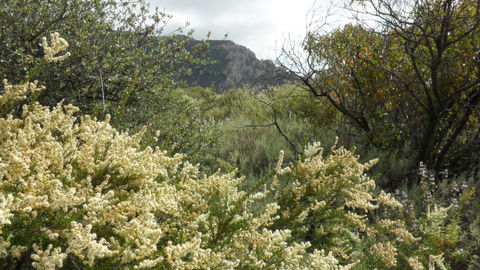
About
Curbing climate warming and mitigating the accompanying impacts of increasing climate variability require a reduction of greenhouse gases (GHG) in our atmosphere, particularly carbon. Achieving carbon neutrality will require both the reduction of GHG emissions and storage in natural ecosystems; however, the primary focus of planning has been on the human environment.
Although nature-based solutions targeting carbon sequestration in forested systems have received substantial attention, California’s chaparral ecosystems have been largely excluded from evaluations and planning due to lack of understanding about carbon dynamics in these systems. However, chaparral is the most extensive vegetation type in the state with potential for above- and below-ground carbon storage.
Project One-Pager
Final Report
Ongoing Efforts:
Expanding our Scientific Understanding of Chaparral Carbon Dynamics
The Connecting Wildlands and Communities (CWC) project was initiated to explore the multiple benefits of integrating natural land conservation considerations into land-use planning to reduce climate impacts and enhance resilience in our local communities and natural ecosystems. Due in large part to feedback from project stakeholders and partners, the CWC project is evaluating the carbon sequestration potential of natural lands in southern California as one of those benefits. Through a collaboration with the University of California, Davis and the U.S. Forest Service, we are working to assess carbon storage dynamics in chaparral ecosystems with a goal of enhancing our understanding of the ecosystem services chaparral systems provide through carbon storage and sequestration.
Future Opportunities:
Integrating Chaparral Carbon Sequestration into Planning
Our collaborative assessment is only the first step in integrating chaparral carbon sequestration into California’s climate change implementation plan and GHG mitigation efforts in southern California. Once our initial effort is completed, there are several steps remaining to integrate this information into land-use planning or consideration of carbon offsets. We are working with partners across San Diego County to establish a framework for how carbon storage in natural landscapes can be integrated into GHG mitigation planning and efforts to achieve carbon neutrality. Understanding sequestration opportunities in natural lands have the potential to help us better achieve climate adaptation and mitigation goals that build resilience in natural communities and help us reach carbon neutrality goals.

On the Blog

Project Partners
The San Diego Foundation
Institute for Ecological Monitoring and Management, SDSU
Climate Science Alliance
University of California, Davis
U.S. Forest Service













